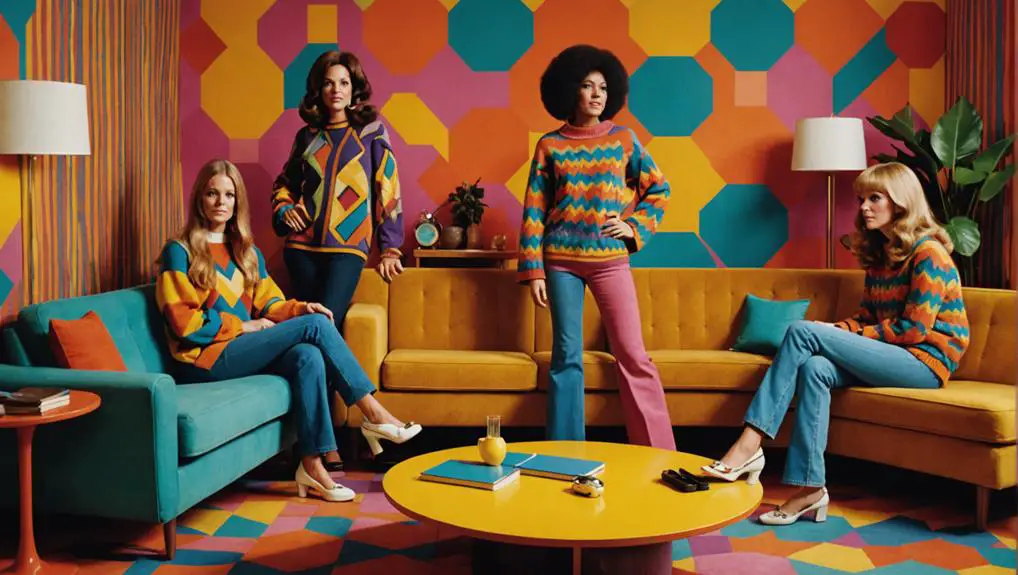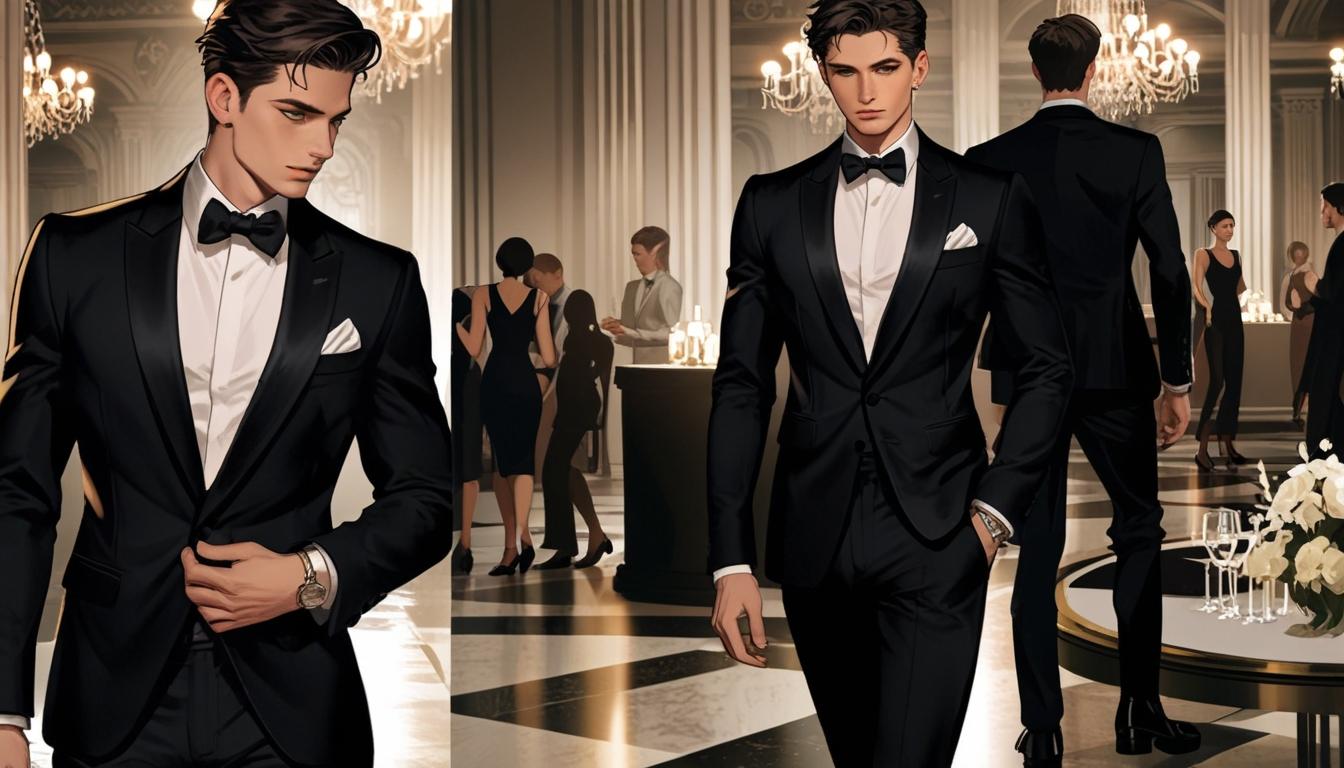In the 1970s, women's jumpers became a vibrant expression of individuality and cultural change, featuring bold colors and eclectic patterns. You'd have noticed oversized silhouettes, turtlenecks, and unique motifs, reflecting the era's playful spirit. Materials like knit wool and acrylic offered warmth and comfort, while intricate designs showcased craftsmanship. Influential designers like Halston and Ossie Clark infused their collections with bohemian and disco aesthetics. The color palette embraced psychedelic prints and floral designs, making jumpers versatile for layering. To truly appreciate these iconic garments, exploring their evolution and impact on fashion can reveal even richer insights.
Overview of 1970s Fashion
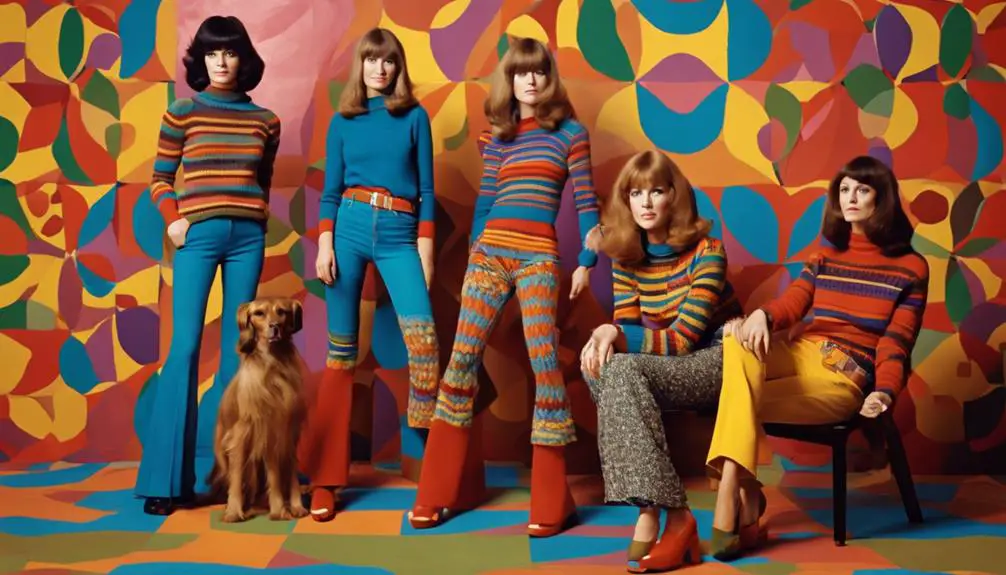
The 1970s fashion scene was a vibrant tapestry of self-expression, where bold colors and eclectic patterns reigned supreme. During this era, women's jumpers became a staple, showcasing the playful and rebellious spirit of the times. Knitwear, particularly those crafted from wool and acrylic, gained immense popularity, often featuring striking designs that reflected the era's diverse cultural influences. Vintage clothing labels played a significant role in identifying iconic pieces, as they often contained unique identifiers and craftsmanship details.
As you navigate through the decade, you'll notice how fashion mirrored the social and political changes occurring globally. Flared trousers and oversized jackets made waves, while knitwear offered a cozy counterbalance, allowing for personal expression amid the chaos. The punk movement later emerged, infusing styles with edgy elements, yet the classic women's jumper remained a canvas for creativity.
Iconic figures like David Bowie and Patti Smith not only influenced music but also shaped fashion norms, encouraging individuality in clothing choices. With vibrant patterns and unique textures, women's jumpers embodied a sense of freedom, making them indispensable pieces in any wardrobe. In this rich context, knitwear transcended mere clothing, evolving into a symbol of rebellion and self-expression that defined the 1970s fashion landscape.
Popular Styles and Trends
Diving into the vibrant world of 1970s women's jumpers reveals a kaleidoscope of styles that perfectly encapsulated the decade's spirit of freedom and creativity. Bold colors and eclectic patterns dominated the scene, influenced by both punk and bohemian subcultures. You'd find oversized silhouettes, turtlenecks, and cropped designs that allowed for versatile layering and personal expression.
Key trends included:
- Wool Knit fabrics that provided warmth and comfort, making them perfect for various occasions.
- Cable Knit textures that added dimension and a cozy aesthetic, showcasing craftsmanship.
- Unique motifs such as Fair Isle patterns and vibrant floral prints that celebrated individuality and artistic flair.
These jumpers not only served as fashionable statements but also reflected the desire for uniqueness. Many pieces were handmade or artisan-crafted, becoming highly sought after today. The 1970s knit sweater was more than just clothing; it was a canvas for self-expression, allowing wearers to embody the playful and artistic spirit of the era. Embracing these styles means embracing a rich history of creativity and personal style that continues to inspire fashion lovers today.
Iconic Designers of the Era
As the vibrant styles of the 1970s emerged, they were often shaped by a handful of visionary designers who pushed the boundaries of fashion. Yves Saint Laurent, for instance, revolutionized women's attire with his "Le Smoking" tuxedo, blending masculine and feminine aesthetics, which allowed women to express power and elegance simultaneously. Meanwhile, Diane von Furstenberg's iconic wrap dress introduced in 1974 became synonymous with women's liberation—its versatility and comfort reflected the era's evolving ideals.
Halston's minimalist designs and luxurious fabrics captured the disco spirit, making his sweaters and cardigans essential for glamorous nightlife. His approach emphasized clean lines, allowing the wearer's individuality to shine through. On the other hand, Ossie Clark embraced the bohemian ethos, crafting flowing, patterned garments that resonated with youth counterculture, encapsulating the artistic essence of the decade.
Lastly, Jean Muir's tailored jumpers and dresses stood out for their elegant simplicity, emphasizing femininity while ensuring freedom of movement. Together, these designers created a dynamic landscape of women's fashion, where sweaters and cardigans became more than mere garments—they were statements of identity and empowerment in a transformative era.
Materials and Fabrics Used
Jumpers from the 1970s showcase a fascinating blend of materials that reflect both the era's fashion sensibilities and its cultural shifts. During this vibrant decade, you'd often find women's jumpers crafted from natural fibers like knit wool, cotton, and acrylic. These materials balanced comfort and warmth, making them staples in any wardrobe. Merino wool, known for its exceptional softness and durability, emerged as a popular choice for high-quality jumpers, elevating the overall aesthetic.
The 1970s also saw the rise of blended fabrics, combining wool with synthetic materials for enhanced durability and ease of care while maintaining style. This innovation allowed for jumpers that could withstand the test of time while remaining fashionable.
- Acrylic: Lightweight and versatile, acrylic jumpers provided an affordable option with vibrant colors.
- Knit Wool: Classic and cozy, knit wool jumpers often featured intricate textures, highlighting craftsmanship.
- Merino Wool: The luxurious feel of Merino wool made it a sought-after choice for those wanting elegance.
These materials not only defined the jumpers but also reflected the eclectic spirit of the time, merging tradition with modernity.
Color Palettes and Patterns
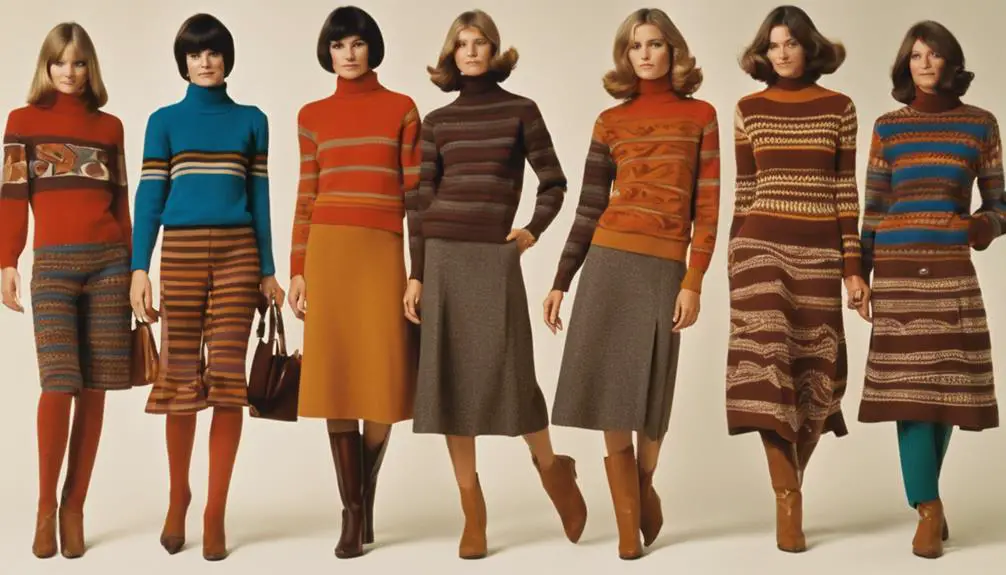
The choice of materials in 1970s women's jumpers set the stage for bold expressions of color and pattern that defined the decade. You'd see vibrant hues like mustard yellow, burnt orange, and deep burgundy dominating the scene, reflecting a daring fashion sensibility. Patterns varied widely, showcasing everything from psychedelic prints to floral motifs and geometric designs.
| Pattern Type | Key Features | Material Blend |
|---|---|---|
| Fair Isle | Intricate designs | Wool and acrylic blend |
| Psychedelic Prints | Bold, vibrant colors | Acrylic blend |
| Floral Motifs | Soft, feminine designs | Acrylic and wool |
Fair Isle and Nordic patterns gained traction, emphasizing both warmth and artistic craftsmanship. The juxtaposition of contrasting colors—think bright stripes and color blocking—added a playful twist to the jumpers. Textures played a vital role, as the combination of acrylic and wool created unique tactile experiences, elevating the visual appeal of these garments. Fundamentally, the 1970s jumpers were more than clothing; they were a canvas for artistic expression, celebrating individuality through color and design.
Cultural Influences on Design
Amidst the vibrant cultural landscape of the 1970s, women's jumpers emerged as a reflection of the era's diverse influences, intertwining artistic expression with social movements. The punk rock movement, with its bold patterns and vibrant colors, inspired designs that captured the spirit of rebellion. You'd notice graphic elements that echoed the works of iconic artists like Patti Smith, emphasizing individuality and self-expression. Vintage clothing labels from this decade, such as Betty Barclay, exemplified the unique styles that resonated with women seeking both fashion and comfort.
Key cultural influences included:
- The rise of counterculture movements embracing unique garment styles.
- A resurgence of retro aesthetics, blending bohemian, mod, and punk elements.
- The craftsmanship of hand-knit designs, often using wool and acrylic for comfort and style.
These jumpers didn't just serve as fashion statements; they told stories of an era defined by change. Many designs reflected Nordic style patterns, connecting the past with contemporary trends. The nostalgic yet innovative look created a space where comfort met creativity. Influencers of the time played a vital role, further solidifying these jumpers as icons of the decade. In this way, women's jumpers became more than clothing—they were a canvas of cultural dialogue.
Tips for Vintage Shopping

Finding the perfect vintage jumper can be both thrilling and challenging, especially with the rich variety available from the 1970s. To navigate this treasure hunt, start by paying close attention to condition ratings like Fair, Good, and New Vintage Deadstock. These ratings give you insight into the quality and wear of the item, helping you make informed decisions. Additionally, understanding the significance of label identification can enhance your vintage shopping experience, as it provides context about the garment's history and value.
Next, don't overlook sizing details. Vintage sizes often differ from modern ones, so always consult size guides for accurate fit information. This guarantees you avoid disappointment when your prized find arrives.
Material composition is another essential factor. Many vintage jumpers feature unique fabrics like wool blends, acrylic, and hand-knitted options, each contributing to the garment's character and warmth. Knowing the materials can also guide your care choices down the line.
Care and Maintenance of Jumpers
When it comes to preserving the allure of your vintage jumpers, understanding care and maintenance is essential. The 1970s jumpers, crafted from 100% Merino Wool, need special attention to maintain their quality and appearance. Dry cleaning is your best option to keep them looking pristine.
To guarantee longevity, consider these care instructions:
- Regularly inspect your jumper for any signs of wear or damage; vintage wool can be delicate.
- Store jumpers folded in a cool, dry place to prevent stretching and maintain their shape—avoid using hangers.
- Keep your jumper away from direct sunlight to prevent fading and deterioration.
When washing is unavoidable, always follow the care instructions and use a wool-specific detergent. This will help preserve the integrity of the fibers, guaranteeing your vintage wool remains a cherished part of your wardrobe. By taking these steps, you'll not only enjoy the beauty of your vintage jumpers but also extend their life, making them a lasting statement piece in your collection.
Styling Women's Jumpers Today
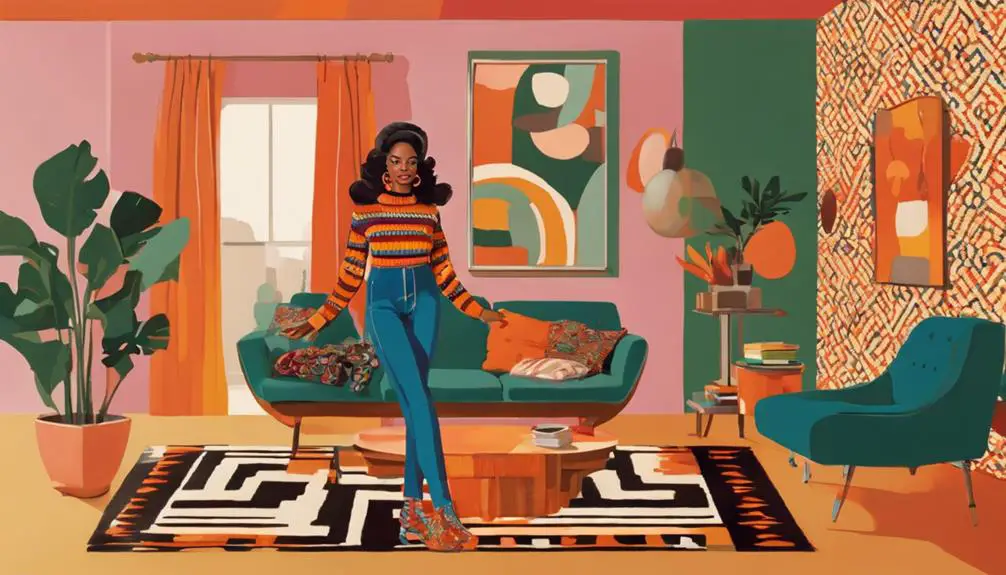
Jumpers from the 1970s are making a bold statement on today's fashion scene, seamlessly merging retro flair with modern aesthetics. Take the 1970 jumper, for instance. Priced at $448.00 and crafted from 100% Merino Wool, it embodies the punk-inspired design that resonates with contemporary styles. You'll appreciate the striking white stripe and black writing, allowing you to pair this versatile piece with everything from casual jeans to chic skirts.
When styling, consider layering it under a classic Cardigan Sweater for added warmth and texture. Alternatively, a Velour Sweater can introduce a luxurious touch, perfect for a night out. For a more sporty look, combine your jumper with a Ski Sweater, channeling a vintage vibe while staying comfortable.
This jumper fits true to size, making it easy for you to find your ideal fit and embrace the oversized trends of the 70s. Remember to dry clean it to preserve its high-quality fabric and maintain its shape. By incorporating these vintage-inspired jumpers into your wardrobe, you're not just making a fashion statement; you're celebrating a rich history of style that remains relevant today.
Notable Vintage Brands and Labels
Vintage brands from the 1970s play a pivotal role in shaping today's fashion landscape, particularly in the domain of jumpers. You'll find that these iconic labels not only reflect the era's bold aesthetic but also influence contemporary designs. Coogi, with its vibrant, multicolored knitwear, stands out as a hallmark of the decade, appealing to those who embraced individuality.
Fred Perry, known for its sporty yet chic appeal, catered to a broader audience while maintaining a trendy vibe, making their jumpers popular among youth culture. Similarly, Dolce & Gabbana burst onto the scene, introducing playful patterns and rich colors that resonated with the fashion-forward crowd.
Here are a few notable brands that shaped the 1970s jumper scene:
- Jean Paul Gaultier: Blended punk aesthetics with high fashion, creating unique knitted pieces.
- Escada: Emphasized quality materials and distinctive designs that remain sought after today.
- Just Cavalli: Featured bold prints and innovative styles that captured the spirit of the times.
These brands not only defined an era but also left a lasting legacy that continues to inspire modern fashion enthusiasts.
Frequently Asked Questions
Did They Wear Jumpers in the 70s?
Yes, they wore jumpers in the 70s, embracing vibrant colors and diverse styles. You'd find oversized, knitted designs popular among youth, with celebrities influencing trends, making these cozy garments a staple of the decade's fashion.
What Jumpers Are Fashionable?
When considering fashionable jumpers today, look for bold patterns and vibrant colors. Oversized silhouettes, unique textures, and layering options elevate your style and express individuality, making them versatile staples in any modern wardrobe.
What Were the Women's Clothing Stores in the 1970s?
In the 1970s, you'd find women's clothing stores like Bloomingdale's and Neiman Marcus bustling with designer styles. Specialty boutiques showcased unique fashions, while chain stores offered accessible options, catering to diverse tastes and budgets.
How Did Women's Fashion Change in the 1970s?
In the 1970s, you'd notice women's fashion embracing freedom and individuality. Styles shifted towards relaxed silhouettes, vibrant patterns, and diverse textures, reflecting broader cultural movements and women's liberation, allowing you to experiment with your unique expression.
